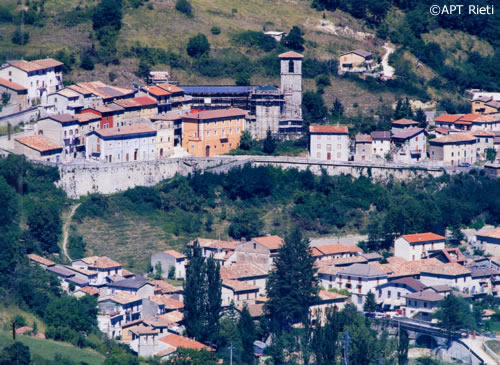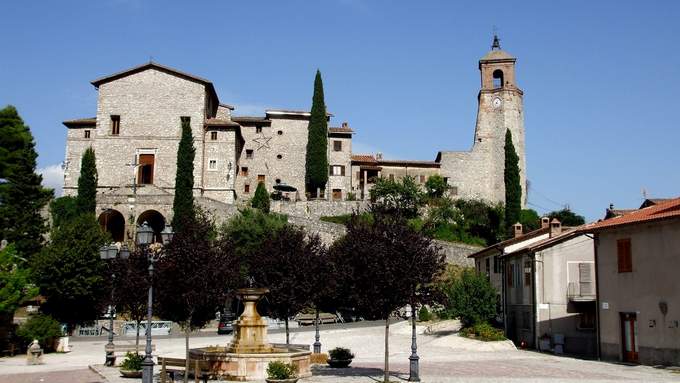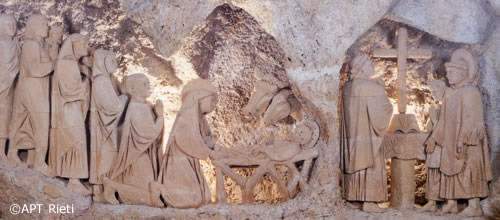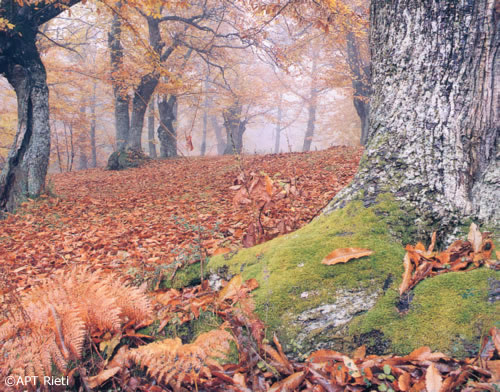|
The walk of the pilgrims continues today ad they did during The Middle Ages: a profound testimony of faith and an exchange between different cultures.
For this reason the Tourism Promotion Agency of Rieti has created the “Saint Francis Walk” (Cammino di San Francesco), a walk through the Valle Santa of Rieti, one of the most important placesin the history of the Franciscan Order. The pilgrimage includes visits to the sanctuaries where Francis travelled to: the Sanctuary of Poggio Bustone, La Foresta, Fonte Colombo and the Greccio Sanctuary.
 It is completed by a climb up Mount Terminillo with a visit to the reliquary of the Saint, a stop at the municipality of Posta and an excursion to the solitary and majestic Beech Tree of Saint Francis in the municipality of Rivondutri. It is completed by a climb up Mount Terminillo with a visit to the reliquary of the Saint, a stop at the municipality of Posta and an excursion to the solitary and majestic Beech Tree of Saint Francis in the municipality of Rivondutri.
The itinerary that winds along 80 km of paths and roads immersed in a spectacular, natural setting in the perfect occasion to renew and revive the intense spirituality of the Franciscan experience. The paths can be done by foot, by bicicle, by mountain bike and by horse. It is also possible to travel by car for those who have difficulty walking or have other ailments.
A subscription and a passport, that will be stamped at each stop on the St. Francis Walk certify the pilgrimage, making it that much more special. The wayfarers on the road of Saint Francis' role as the Patron Saint of the Environment in a land that is, and wants to remani, uncontaminated.
The Walk has the same spirit based on the Franciscan belief of purity and and poverty and brings back the values of the Rule of the Franciscan.
Order that Saint Francis wrote for his brethren and the whole world from Valle Santa.
Franciscan sanctuaries in the Santa Reatina valley
Sabina, descibed and immortalized by writers and poets in Roman times, was singled out by the great Italian St. Francis of Assisi who expressed his love of nature and all her marvels in his “Canticle of Creatures”.
He loved Sabina region above all others, and in particular the area between the Valley and surrounding heights.
There are four Franciscan sanctuaries in the Valle Santa of Rieti and the neighbouring hills.
They are called the Sanctuary of Poggio Bustone, the Sanctuary of La Foresta, the Sanctuary of Fonte Colombo and the Sanctuary of Greccio.
The Sanctuary of Poggio Buscone
Leaving the Spoleto Valley, St. Francis went topray to the hills overlooking Poggio Bustone, 10 miles from Rieti; the legend tells that, when St. Francis with his friends first came to the Holy Valley in 1209 to escape the ridicule and hostility of his fellow townsmen, he greeted the local people with the simple words “Good day to you good people”and the villagers, in turn, exchanged the same greeting and have continued to do so over the centuries.
In the most wild part of the mountain he found two caves where he prayed and chastised himself in penance; during his meditazione he was assured of forgiveness of his sins and was told that his brethren, the new apostles would grown in number.
The Sanctuary of Fonte Colombo
The Sanctuary of Fonte Colombo is 3 miles from Rieti, known as the Franciscan Sinai, because it was here in 1223 that St. Francis received the final Rule of the Friars Minor from Christ. Following this the Saint left to preach in the Orient where he contracted a very painful eye disease.
He tan returned to Fonte Colombo to cure it and here performed other miracles.
It is natural, therefore, that what attracts us most to this quite peaceful hermitage it is its mystical athmosfere not its artistic value. The sanctuary stands on a hill-top still covered to this day with luxuriant vegetations and ancient holm-oaks at in altitude of 1788 ft.
There is a small chapel dedicated to the Virgin called “ Cappella della Maddalena”, which stands in the natural cave where the Saint used to pray, the so-called “Sacro Speco”, or “Holy Cave”, and in one of the left of the altar the letter T (tau in greek) is clearly visible: it represents the Cross that is, in effect, the Saint's symbol.
 The Sanctuary of La Foresta The Sanctuary of La Foresta
The Sanctuary of La Foresta is 2,5 miles from Rieti, a shrine on the plase where St. Francis stopped to have his eyes treated while travelling to Rieti at the invitation of Cardinal Ugolino, in 1225. This was where Saint Francis came to get away from his all too faithful followers. He stayed as the guest of the Parish Priest of the little church of St. Fabiano; it was at this time that the miracle of the grapevine took place. The huge crowds that had gathered to get a glimpse of the Saint wrecked the vineyard, but it nevertheless produced an exceptionally rich harvest of excellent quality wine.
The story is depicted in a 16th century fresco, in the portico.
The Sanctuary of Greccio
At the western end of the Rieti Valley, 10,5 miles from Rieti, is the Sanctuary of Greccio, known to the world as the Franciscan Bethlem, a large and overpowering architecture: the buildings seem to grow out the rock reinforced by heavy pilons. It was here, in the winter of 1223, that St. Francis thought of commemmorating the Birth of the Infant Christ at the approch of the Feast of the Nativity, and on Christmas Eve night, the worls saw its first Crib with an ox and an ass standing round a manger on wich the priest celebrated the Mass.
The story is also depicted in the valuable 14th century fresco in the Chapel built right after the Saint's death in the same grotto where the Saint assembled the Crib. Since 1972, during the Christmas season, a series of live open-air scenes are organized so that the experience of the firs Crib can be renewed.
The Temple of Saint Francis
 In 1939 Pope Pius XII declared Saint Francis the Patron Saint of Italy. In order to celebrate the event, the Franciscan friars decided to build a monument on Terminillo at 1623 m. above sea level. They erected the national Votive Temple. Work began in 1949 and 25,000 cubic meters of rock was carved out in order to house the church which was consecrated in 1964. In 1939 Pope Pius XII declared Saint Francis the Patron Saint of Italy. In order to celebrate the event, the Franciscan friars decided to build a monument on Terminillo at 1623 m. above sea level. They erected the national Votive Temple. Work began in 1949 and 25,000 cubic meters of rock was carved out in order to house the church which was consecrated in 1964.
The building is a harmonious fusion of architecture, mosaic, sculpture and church ornaments of high artistic quality. A casket in the Saint Francis chapel holds the most precious relic: an urn containing remains of the Saint in front of which a votive lamp burns eternally.
Saint Francis' beech tree
St. Francis withdrew often in the Holy Valley in order to find the solitude offfered by the extraordinary natural elements of the places. One of the most fascinating is the St. Francis' beech tree, a monumental tree with its foliage that extends to 22 meters in diameter. The tree is famous for its extraordinary form, with branches that entwine, creating curves and knots with unusual beauty.
It is fruit of a spontaneous mutation undergone in only rare examples throughout the world. According to tradition, during a storm, the tree took on this form in order to protect St. Francis who had been praying there. One can get there by following a secondary road from Rivodutri that goes to Cepparo; one continues, submerged in nature, up to the foot of Mount Fausola (1100 meters) where a sign indicates a small path which leads to this extraordinary beech tree.
The Village of Posta
Some Franciscan historians and a local ancient tradition believe that Francis came to the village of Posta wich was called Malchiloneduring the Saint lifetime.
In the village, which borders the Kingdom of Naples, St. Francis founded the first order of the Friars Minor in the Churc of St. Mathew known today as the Church of Saint Francis.
The presence of St. Francis in Posta begins beetween 1222 and 1225.
On the site where St Francis lived, a convent soon arose and the ancient church of St. Mathew was renovated to become largee and more solemn.
Sources say that as a token to the love and affectoin he held for the poor and the sick, St. Francis donated, his cloak and twelve loaves to a poor woman from Machilone with sick eyes who did not have the money for a cure.
Natural Elements The vista is open spacious, marked by rows of poplars that break up the planted fields.
The surronding hills lead the eye skyward, towards the peaks, of the Terminillo in the background.
This is how the Rieti valley appears today, where centuries ago St. Francis first set out the Walk.
When St. Francis exploredthis valley, he discovered an extraordinarily varied nature, alive with multi-hued colors, varying from the valley to the hill.
Enormous oaks define the landscape bordering the lake regions, and the areas where the Saint one walked must have been cloaked in forests and brush that are still present in large part today.
Despite reapeated attempts to reclaim the area during Roman times, by mining the travertine bank of the Marmore Falls from the ancient Iacus Velinus, wich deates to the Quaternary period, extended across the Rieti plain.
Ancient sources claim that the Saint was forced to use a boat to cross the basin to get from one side to the other.
At the time, large mammals populated the area, including deer that subsequently found refuge in the hills before indiscriminate hunting wiped them out altogether.
St. Francis used to converse with the elements of nature that surrounded him on a daily basis.
But what does the area, that prompted the Saint's mystic fervour, look like today? It's certain that St. Francis knew the towns of Poggio Bustone, Greccio, Fonte Colombo, La Foresta, the best known Franciscan localities of the Rieti area.
But there are others worth noting, either because they are the site of miraculous events - like St. Elia - or because they are linked to legends passed down through the ages, like the legend of the beech three on the mountain above Cepparo di Rivodutri.
The Walk of Francis includes Pian de' Valli on Mount Terminillo and the village of Posta in the high valley of the Velino.
The vegetations one encounters on the various itineraries is extremely rich and mutable according to the season.
Species variety is so abundant that it's rare to encounter it elsewhere.
The lakes of the plan (at 370 metres above the sea) are in good state of preservation, lush with the vegetation, typical of areas that are both perennially submerged and dry in others parts.
Surrounding the lakes of Ventina, Ripa Sottile, Lungo or Cantalice, Fogliano to name the most important, are forests mostly populated by willow trees, white poplars, black elders along with travelers-joy, bramble bushes and hop, which ensure a large degree of diversity.
In certain periods of the year, these are inhabited by cormorants, egrets, grey herons, marsh harriers, buzzards and the like.
The riverbeds are framed by vegetation typical of marshy areas.
The water irises are especially beautiful during the soring bloom.
The marshy areas provide home to manynbirds that find their ideal habitat here and come to nest.
Thus little grebes, whistle ducks, mallards, teals, pochards, spoon-billed ducks, bulls of the bog, little egrets, moorhens and other birds live in these areas where land, water and plants seem to merge into one extraordinary ecosystem.
But similar woods are present along the rivers Velino, Salto, St. Susanna.
This is the ideal environment for porcupines, foxes and other wild game.
Beyond the fields, the geometry of bushes and the inuque, woods defined by olive groves, the mixed broad-leaved forest becomes the protagonist. Normally these are decidous species that lose their leaves after autumn's bright palette of colours dulling the landscape into depressing tones.
Oak trees, the friendly giants of the forest, spring up here and there.
Up higher, chestnuts form, woods, that have always been planted and cared for by man.
Known as the tree of bread and good wood, the broad trunk chesnut brings us into an enchanted fairytale world, that's not just, in our imagination.
Surrounding the Sanctuaries, at times forming a crown around the walls, are holmoak woods.
They have been there from time immemorial and with their dark green foliage they confer an air of solemnity ti the environment.
Higher still a beech forest, dominates the landscape, the tall columnlike trunks decorated by multicoloured lichens, which stand silhouetted against a winter's sky or against the warm green of the hot season or against brilliant autumn colours.
The territory belongs to animals that take shelter from man, but make their presence known especially once the sun goes down.
It's the land of the fox and the badger, squirrel and dormouse, woodpeckers and jay, wise old owl, and the hoot owl with its sad song along with hundreds of iìother song birds.
To sum up, along the paths trodden by St. Francis one finds the simplest - hence the most sublime-spirituality.
One climbs with the trees, following the changing landscape.
Below the fields speak of ancient history, of a farming community that for centuries lived off the resources of the land, at times generous mother, at times hostile antagonist.
A history written by pollard willow trees, elms used to steer vines, oaks the provided, shade to herds, poplars that towered along the ditches.
Up higher, the path becomes a forest that varies and changes in form, and colour; the maple, ash, sorb, oak, laburnum, and spashes of juniper and broom that alternate with the high pastures beech groves and of spires of St. Francis'rocky cathedrals.
Following the Walk, panoramas, open up unexpectedly: high plateaus and deep valleys, thick forest and immense isolated trees.
The rough and gnarly trunks seem to annonce that for centuries these natural fortresses were the custodians of the Franciscan Rule.
So the centuriesold Beech of St. Francis, with its imposing and twisted trunk so different from others of the species, appears to be the entrance way to God's temple on earth.
TEXTS AND IMAGES COURTESY OF TOURISM PROMOTION OFFICE OF RIETI |



 Munch: The Scream Within
Munch: The Scream Within In the garden
In the garden Perugia Travel Guide
Perugia Travel Guide


 It is completed by a climb up Mount Terminillo with a visit to the reliquary of the Saint, a stop at the municipality of Posta and an excursion to the solitary and majestic Beech Tree of Saint Francis in the municipality of Rivondutri.
It is completed by a climb up Mount Terminillo with a visit to the reliquary of the Saint, a stop at the municipality of Posta and an excursion to the solitary and majestic Beech Tree of Saint Francis in the municipality of Rivondutri. The Sanctuary of La Foresta
The Sanctuary of La Foresta  In 1939 Pope Pius XII declared Saint Francis the Patron Saint of Italy. In order to celebrate the event, the Franciscan friars decided to build a monument on Terminillo at 1623 m. above sea level. They erected the national Votive Temple. Work began in 1949 and 25,000 cubic meters of rock was carved out in order to house the church which was consecrated in 1964.
In 1939 Pope Pius XII declared Saint Francis the Patron Saint of Italy. In order to celebrate the event, the Franciscan friars decided to build a monument on Terminillo at 1623 m. above sea level. They erected the national Votive Temple. Work began in 1949 and 25,000 cubic meters of rock was carved out in order to house the church which was consecrated in 1964.
